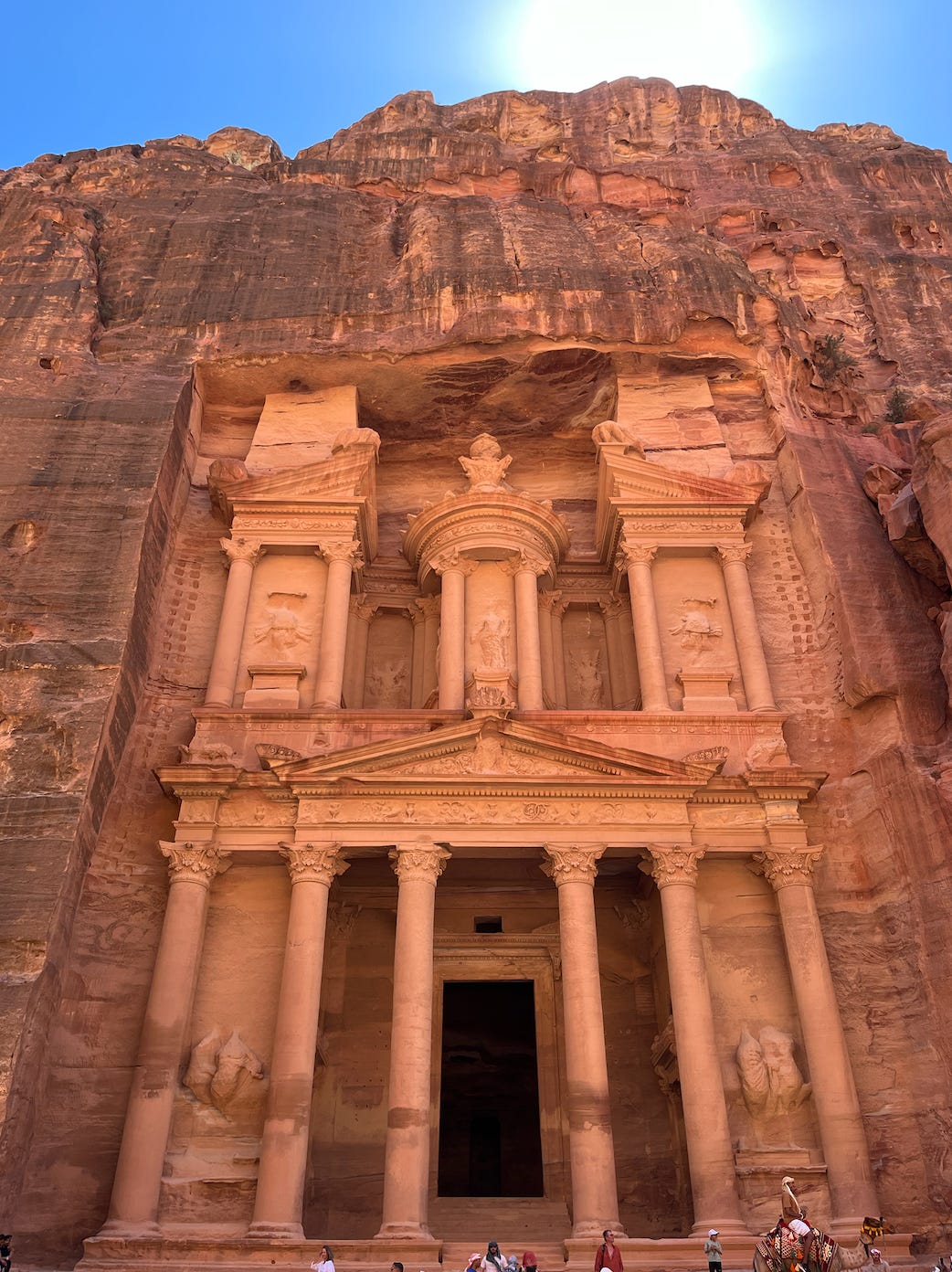
Dear Classical Wisdom Members, “It’s very easy these days…” concluded our guide as we drove past the recent Bedouin village. “They are able to get water from a truck. They used to walk down the canyon to the spring to collect it. That was when they still lived in the caves in Petra.” “When was that?” my husband inquired, watching the kids race their donkeys down the street. “About 60 years ago.” Today dear reader, I’m writing from a desert camp about two hours south of the lost city of Petra. We spent the last few days visiting the Treasury, the Great Palace as well as the Monastery (via the “easy” back route which included a two hour hike with very sheer cliffs.) Share Built by the Nabataeans potentially early as the 5th century BC (though it was at its height in the first century AD), the site is considered rightfully a wonder of the world. Pliny the Elder describes in his Natural History, “the Nabataeans inhabiting a town named Petra; it lies in a deep valley a little less than two miles wide, and is surrounded by inaccessible mountains with a river flowing between them.” What struck me upon arrival to the “Rose city” as it’s sometimes called, was the notable Hellenistic influence. At first glance, you are met with Corinthian columns, dentil motifs, egg and darts and the remnants of an engraved Castor and Pollux, the mythological Greek half brothers of Leda, flanking the entrance. One could easily be forgiven for thinking they were in Alexandria… especially when you notice the Isis-Tyche figure on the tholos above. The Nabataeans, an ancient Arab tribe described as fiercely independent by contemporary Greco-Roman accounts, were excellent traders… and the diverse influences in their architecture, the capital of their own powerful kingdom, reflects this. They were in contact with many peoples who were greatly impacted by Hellenistic culture… and it is astonishing to be reminded just how interconnected the ancient world was. Of course, as you travel through this ancient city, you’ll see the local Nabataean and later Roman influences as well. For instance, walking further through the site you find an astonishing Roman theater, carved directly into the mountainside during the reign of King Aretas IV (4BC-AD27), and later extended and rebuilt by the Romans. It apparently could hold 8,500 people… though other sources say 4,000. Reading the information as we encounter the site: Later we came upon the Great Temple, abandoned until its recent re-discovery in 1992 by Brown University… and there a fantastic Nabataean touch awaited us with an elephant headed capital! This has lead to lots of pondering on the influence of Elephants in the ancient world… The final spot we visited was the Monastery. While tricky to reach, it was stunning once we arrived… and certainly demonstrated both the Hellenistic flourishes, as well as Nabataean design. Look at the capitals! How cool… By the way, if you are interested in a kid’s eye view on these travels, make sure to follow Frida and Owly, either on Classical Wisdom Kids or the Classical Wisdom Kids Youtube channel, just launched! While the Nabataean kingdom became a client state of the Roman Empire in the first century BC, it was only in 106 AD that it lost its independence… and in 363 the Galilee earthquake gave it a fatal blow. In the Byzantine era, several Christian churches were built… but it was eventually abandoned all together. The story of its rediscovery by the extremely dedicated master of disguise, Swiss travel Johann Ludwig Burckhardt, is an astonishing tale in and of itself. The young man died at 32 after finding both Petra and Abu Simbel in Egypt by immersing himself so totally in the Arabic culture, eating with the camel drivers and being accepted by the Bedouins. His research and notes are immense… but that will have to save for another day. Leave a comment In the meantime, Classical Wisdom Members, I have collected this month’s resources for you below, including the Ebook on Constantine, the Classical Wisdom Litterae Magazine on the ancient Jews, our Podcast with Professors discussing ancient game theory and this last week’s webinar on ancient Bathhouses. I will have an in-depth article on the Age of Heroes and the Mycenaeans next week. Also, please make sure to register for our next Roundtable discussion on James Joyce and the Classics. Don’t worry! You do not need to be familiar with Joyce’s works -or have read them- to enjoy this conversation. We will make sure to include both beginners and experts (and everyone in between) in this conversation. Learn more about the Roundtable Discussion and how to register HERE: Read more - Enlace a artículo - Más info en frasco@menadelpsicologia.com / Tfno. & WA 607725547 Centro MENADEL (Frasco Martín) Psicología Clínica y Tradicional en Mijas Pueblo #Psicologia #MenadelPsicologia #Clinica #Tradicional #MijasPueblo *No suscribimos necesariamente las opiniones o artículos aquí compartidos. No todo es lo que parece.



No hay comentarios:
Publicar un comentario